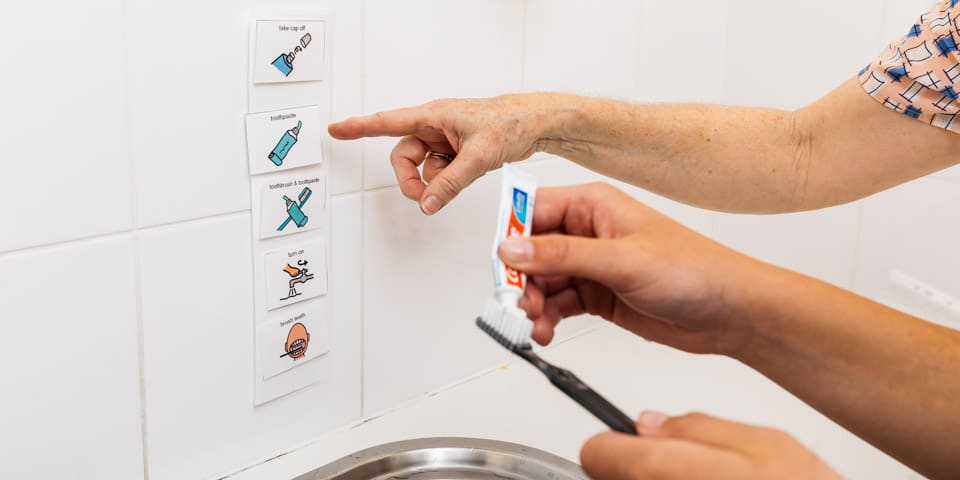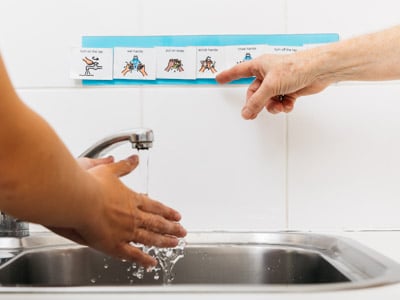فعالیت های زندگی روزمره
If you are on the autism spectrum, or your child has been diagnosed with Autism Spectrum Disorder (ASD), you might find everyday routines, tasks and activities a little more difficult.
Because of this, it can be helpful to break down daily tasks into steps that will allow you or your child to learn how to better manage, and take control, of daily routines and activities.

What are daily living activities?
Activities of daily living are the routines people undertake on a regular or daily basis, and often take for granted, these include:
- Meal times: preparing and eating regularly, including breakfast, lunch, dinner.
- Self-care: showering or bathing, getting dressed, cleaning teeth, doing hair and clipping nails.
- Sleeping.
- Toileting.

Why are daily living activities important?
- Independence: if you are able to look after yourself by undertaking these key activities of living you are more likely to be able to live safely and independently as an adult.
- Self-esteem: self-reliance helps with self-esteem, it feels good to be able to look after yourself without needing help.
- Less reliant on others: as with the above two points, it’s an excellent goal to be able to function on your own without needing assistance from other people if possible.
- Skills for life: these daily living skills are tasks that everyone needs to undertake every day throughout their life. If you can learn to undertake them yourself early, it will make life a lot easier and improve your quality of life.
Daily living strategies for people with autism
Because autism is a developmental difference, people with autism can often find it difficult to learn and manage everyday tasks, like taking a shower, getting dressed, brushing their teeth and packing their school bag; or daily chores like making their bed, or setting the table.
People on the spectrum often need to plan tasks in order to know that they are necessary, and as such, may need reminders and extra support to incorporate tasks into their daily lives.
You can help a person on the spectrum to develop these daily skills through the step-by-step teaching technique. This includes:
- Ensuring they are aware of the necessity of the activity.
- Breaking tasks down into simple step-by-step routines.
- Teaching them the each step and encouraging them through the steps daily.
- Gently providing prompts to support the completion of the task.
- Celebrating and rewarding success when milestones are achieved.
An Occupational Therapist can help you or your child to learn how to undertake these everyday tasks, and can give you advice about how to help yourself or a person on the spectrum to incorporate these tasks daily.

Teaching everyday skills to people with autism
The following steps will assist you in helping your child, or dependant, to develop daily living skills.
Step 1: develop awareness
Develop their awareness of certain skills by drawing their attention to the skill that needs to be developed. Whether it be brushing teeth, dressing or toileting.
Step 2: identify a goal
Choose an appropriate goal that suits their age and abilities. Try not to introduce too many goals to achieve at once, and start slowly.
If getting dressed in a timely way, without distraction, is a skill you’d like them to develop, you could focus the goal on getting dressed, and start by just getting them to put on one piece of clothing themselves, like a pair of pants.
Step 3: break it down
Break down the task as much as you can, for example, putting on a pair of pants has a number of steps which lead to the ultimate goal. Including, getting the pants out of the draw, holding the outside of the waist, stepping into the pants, first one leg, then the other, and pulling them up.
You might find it useful to draw the process, use pictures or photos of the process, model the process, or show the process on a video through video modelling of how to undertake the task.
Step 4: teach each step
It’s important to teach each step separately, so they can learn how to undertake the task incrementally. Make sure you check with their occupational therapist about the level of the task at hand, so you’re not undertaking anything that is too advanced. Doing up buttons, for example, can be very challenging for young children. You can help them to learn each step by:
- Providing them with lots of opportunities to practise.
- Rewarding and praising effort, every good attempt and celebrating results.
- Visually showing them what to do.
- Helping and prompting them throughout the task.

Forwards or backwards teaching?
You can undertake key steps in your child, or dependant’s, daily living routine by either moving forwards or backwards, eg. teaching the first step, then the next step and so on (forwards); or teaching the last step, then the second-last step and so on (backwards).
Many occupational therapists recommend teaching backwards – starting with the last step first, because:
- It’s often more rewarding to finish a task than to start one.
- There is usually an instant outcome or a motivation from finishing a task, eg. once you’ve put your jeans on you can start your day, or go out and play!
Forwards teaching can be useful for some things, like remembering numbers or addresses, and some people with autism find the structure of starting at the beginning easier to follow.
Keep in mind every person is different, so consider the best approach for you, your child, or dependant and make sure you ask a professional, such as an occupational therapist, for their advice about the best approach at each age and developmental level.
For more information about specific strategies and interventions to assist with development visit our behavioural strategies, communication strategies, social interaction strategies, and sensory strategies pages.
You can also find more information about specific autism Supports and Services here, or contact information for local autism associations at our Resources page.



